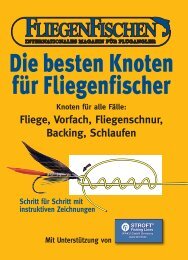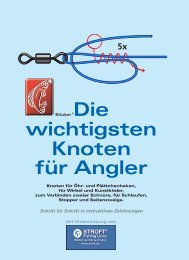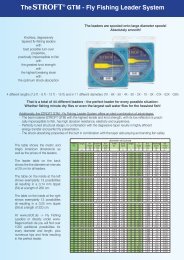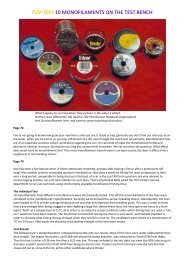SHOP WINDOW TEST - STROFT Fishing Lines
SHOP WINDOW TEST - STROFT Fishing Lines
SHOP WINDOW TEST - STROFT Fishing Lines
You also want an ePaper? Increase the reach of your titles
YUMPU automatically turns print PDFs into web optimized ePapers that Google loves.
<strong>SHOP</strong> <strong>WINDOW</strong> <strong>TEST</strong><br />
1. The blind test<br />
In the blind test for suppleness,<br />
rigidity, surface structure and<br />
braiding, one thing became clear<br />
to us very quickly; it is not always<br />
obvious from looking at and<br />
feeling the lines how the<br />
manufacturers arrive at their<br />
respective diameters. Some lines<br />
felt much thicker than<br />
advertised. This is because there<br />
is no uniform method of<br />
determining the diameter of<br />
braided lines. Many lines are not<br />
round but flat, so no correct<br />
diameter can be given. We found<br />
the manufacturers’ specifications<br />
equally unreliable; one of the<br />
lines with the smallest indicated<br />
diameter was in our judgment<br />
quite clearly the thickest and a<br />
0.18 mm line seemed more like a<br />
0.08 or 0.10 mm.<br />
The surface structure of the<br />
various lines also exhibited<br />
substantial differences. Some felt<br />
very rough, while others were so<br />
smooth that they could almost<br />
have been taken for monofil. This<br />
is because some brands are<br />
sealed or waxed to increase their<br />
suppleness.<br />
All manufacturers try to<br />
produce the roundest possible<br />
lines, which are easy to cast and<br />
absorb little water. However,<br />
only a few of the lines that we<br />
tested can be described as<br />
anything like round. At first sight,<br />
in fact, some of them look<br />
distinctly flat.<br />
In terms of suppleness or rigidity,<br />
our assessments ranged from<br />
very stiff to very supple.<br />
In the blind test, the surface, suppleness and braiding were<br />
examined and compared – with surprising results: lines with<br />
similar manufacturers’ details exhibited significant differences.<br />
The choice of line always<br />
depends on personal preference.<br />
Some anglers like smaller<br />
diameter lines to be a bit stiffer,<br />
so that the line doesn’t get<br />
caught around the rings when<br />
casting or twist itself into tangles<br />
when limp. Others prefer a more<br />
flexible line that runs quickly off<br />
the reel allowing one to place<br />
baits and fish lures with<br />
accuracy. Despite these different<br />
preferences, three lines emerged<br />
as the winners of the “dry test”<br />
in the office.<br />
Stroft GTP from<br />
Waku, type 2;<br />
0.18 mm, tensile<br />
strength 4.0 kg:<br />
Despite its large indicated<br />
diameter (type 2 = 0.18 mm), this<br />
line was judged extremely thin,<br />
and the majority of the testers<br />
liked its suppleness. It also re‐<br />
ceived best marks for having a<br />
very round cross section.<br />
Jigmaster Super<br />
Braid from Roze<br />
meijer; 0.10mm,<br />
tensile strength<br />
6.1 kg:<br />
For the Jigmaster, the indicated<br />
diameter tallied with the testers’<br />
estimates. The line felt very thin,<br />
and its round braiding and<br />
smooth surface also scored<br />
highly.<br />
Berkley Fireline;<br />
0.12 mm, tensile<br />
strength 6.8 kg:<br />
The Fireline scores with its<br />
smooth surface and is rated<br />
practically round. It is a front<br />
runner for lovers of stiffer lines.<br />
2. The practical test<br />
Kitted out with rods, reels and<br />
braided lines, we went down to<br />
the water for the practical test,<br />
where we compared the casting<br />
qualities and behaviour of the<br />
lines on the reel. First, we looked<br />
at the reels, to assess the way<br />
the lines lay. Most of the lines<br />
tested lay relatively smoothly on<br />
the reel, so we were able to<br />
award good marks across the<br />
board in this category. Two lines<br />
stood out especially, receiving an<br />
unanimous “very good”. Then we<br />
moved on to test the casting<br />
qualities of the lines. At first we<br />
were not sure whether we would<br />
find any differences at all<br />
between the various lines; but in<br />
practice, it only took a few casts<br />
to remove our doubts: although<br />
no line came out as<br />
“unsatisfactory”, small but subtle<br />
differences could be seen. Some<br />
lines shot off the reel like<br />
greased lightning, and even a<br />
casual underarm cast threw<br />
them astonishing distances.<br />
Other lines, on the other hand,<br />
felt slightly wiry and were not so<br />
easy to cast.<br />
Finally, we tested their resistance<br />
to abrasion. Particularly where<br />
there are a lot of stones, mussel<br />
beds or sunken pieces of wood in<br />
the water, the line needs to be as<br />
abrasion resistant as possible. A<br />
good fish on a damaged line is<br />
usually a lost fish. In order to<br />
simulate these conditions, the<br />
lines were drawn across a rusty<br />
and sharp‐edged surface. The<br />
differences in the resistance to<br />
abrasion were amazing; two lines<br />
snapped after just a few rubs,<br />
while others proved much more<br />
hard‐wearing. The top performer<br />
actually turned out to be ten<br />
times stronger than the weakest<br />
line. However, this result needs<br />
to be treated with caution:<br />
thicker lines have more<br />
individual strands and a<br />
significantly larger surface area.<br />
This makes them much less<br />
susceptible to wear.<br />
The practical test also produced<br />
three clear winners:<br />
Matrix Pro from<br />
Sufix;0.12 mm,<br />
indicated tensile<br />
strength 4.5 kg:<br />
The Matrix Pro stands out; it lies<br />
well on the spool and casts out‐<br />
standingly. With this line, you<br />
can hit distant spots<br />
accurately.<br />
As with all<br />
three winners<br />
of the practical test<br />
marks only had<br />
to be deducted<br />
for resistance to wear.<br />
Jigmaster Super Braid<br />
from Rozemeijer;<br />
0.10 mm, tensile<br />
strength 6.1 kg:<br />
Its way it lies on the spool is first‐<br />
rate, with no crooked winds to<br />
spoil the extremely good overall<br />
picture. In casting too, the<br />
Jigmaster makes an excellent<br />
impression.<br />
Stroft GTP from Waku,<br />
type 2; 0.18 mm,<br />
tensile strength 4.0 kg:<br />
As in the blind test, the Stroft<br />
GTP emerged from the practical<br />
test as one of the best lines. It<br />
winds in smoothly and lies very<br />
evenly on the reel. Its suppleness<br />
allows it to be cast great dis‐<br />
tances.<br />
On the water, the<br />
different properties<br />
of the braided<br />
lines became clear:<br />
when casting,<br />
some lines ran<br />
off the reel very<br />
easily, while others<br />
felt rather stiff<br />
and slowed the bait<br />
on the cast.<br />
Differences could be seen in<br />
the way the lines lay on the<br />
reels. Even on the same reel,<br />
not all lines lay equally well.






